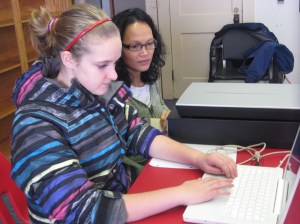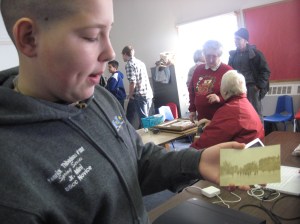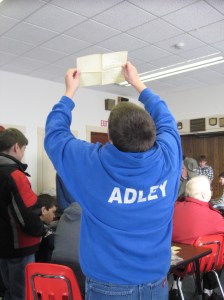PERU — A former classroom in the old Peru Elementary School was filled with activity Wednesday morning as students and historical society members held a Scanning Party.
It was an effort to add old photographs, letters and artifacts to the database of the Maine Memory Network. The project, taking place in many towns around the state, aims to preserve the histories of towns and their people at the Maine Historical Society website.
Kurt Rowley, a social studies teacher at Dirigo High School in Dixfield, and Michelle Ladd, a teacher at the Holy Savior School in Rumford, were thrilled to see how interested their students were in the history of their towns.
“We’re trying to get as many primary resources as possible,” Ladd said. “Letters came from all over the country. We weren’t just pioneers. Letters were the Facebook.”
Rowley, who teaches an elective course in River Valley history, said the project was not one of just learning, but also a mixture of the generations.
“Getting people separated by decades together in one room is extraordinary,” he said.
Kenric Thibodeau, an eighth-grader at Holy Savior, was excited to see a century-old photograph of local people skating on a nearby pond. He also read a 1907 letter written by someone who was paralyzed.
One high school boy was setting up a digital camera to take a photo of a really old, hand-drawn map of the former Franklin Plantation. Peru Historical Society President Bob Dolloff said the plantation was eventually divided up for the towns of Rumford, Peru and Sumner. That photo will eventually be scanned and entered into the Maine Memory Network archive.
Jon Adley, an eighth-grader, tried to find a watermark on one of the dozens of letters being scanned.
“This is pretty neat. They wrote letters. They had no cellphone or Facebook,” he said.
Irene Hutchinson, a member of the Byron and Mexico historical societies, was thrilled to have the children involved.
“They have the technical skills to do this,” she said.
Rumford Historical Society member Nghia Ha assisted sixth-grader Kirsten Soucy scanning in a photo of Canal Street in the 1920s when piles of wood were stacked along the shore of the river.
The scanning project will continue for several months, thanks to a grant that Nick Waugh, a technology instructor at Dirigo Elementary School, was able to get.
Teachers, students and historical society members all agree the project is a fantastic one for the communities of RSU 10.
“It is an enormous resource for students,” Ladd said.
The historical societies of Byron, Buckfield, Rumford, Mexico, Peru and Dixfield are participating in the long-term project.
The committee meets again at 3 p.m. Dec. 19 at a place to be determined. The historical societies and students will be updated on the progress.
Waugh said a community event will likely take place sometime in the spring.
Those who wish to view the photos, letters and other artifacts already on the website may go to www.mainehistory.org



Comments are no longer available on this story